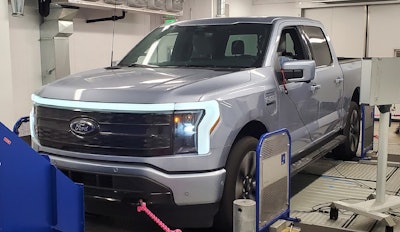
While electric pickup manufacturers have won over buyers with zero emissions, impressive speed and low total cost of ownership, it’s those towing and hauling capabilities that continue to drag these new workhorses down.
Oops! That might be the first mistake. Can all-electric pickups be counted on as serious workhorses on par with internal combustion? After all, electric or not, trucks can be called upon to do truck things like towing and hauling.
Hard Working Trucks published towing test results of the 2022 Ford F-150 Lightning which were disappointing in terms of range depletion. The truck handled remarkably well being a heavier Class 2 truck (thanks to the porky battery) and acceleration was great. But having 122 miles of range to tow a 7,000 lb. load following a full charge through overnight AC charging was far from satisfactory.
Now AAA has published its findings on the payload capability of the 2022 Lightning and it’s not exactly something to cheer about.
After loading the truck bed with 1,400 pounds of sandbags, 110 pounds shy of its maximum capacity, AAA Automotive Engineering researchers discovered that Lightning’s range dropped 24.5% from 278 to 210 miles.
“Our testing revealed a significant range reduction, but it’s important to note that the Lightning was loaded to near its maximum capacity,” said Greg Brannon, director of AAA Automotive Engineering. “Most buyers will likely use their Lightning with a lighter load, resulting in a much smaller range reduction.”
AAA points out that internal combustion (IC) trucks also lose range while hauling. However, unlike IC vehicles which get better fuel economy on the highway, EVs actually lose more range there versus city driving where slower speeds and regenerative braking lead to improved energy performance.
AAA also cautions fleets and work truck owners to keep in mind that equipment racks, toolboxes and other work-related accessories will increase energy use and continue to cut into range because after all you’re adding to the vehicle’s overall weight.
Despite the range challenges, AAA applauds EVs for requiring less energy to perform a task than their IC counterparts and that battery technology will continue to improve so that range becomes less of an issue.
In the meantime, they advise knowing full well your duty cycle demands and to shop accordingly. As HWT pointed out in its Lightning review, if the truck’s boundaries are respected, you can have a much more powerful pickup that will be much less expensive to maintain.
The problem, of course, is finding the extra time for charging. If I had to travel 500 miles with that 7,000 load, I would have stopped four times for DC fast-charging. At 45 minutes per charging session to 90% state-of-charge, that would mean spending 180 minutes for charging. Even with a gas-hungry V8 half-ton stopping twice for fill-ups, that would amount to roughly 15 minutes or so in gassing up for that same trip. So...since time is still money, electric pickups still need a lot of help in the battery department unless you don't really need to tow or haul that much or that far.









